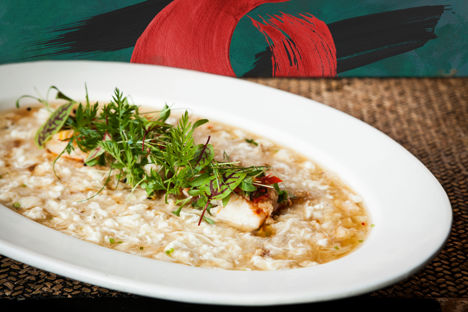
Painting a picture: mock crab and aged wine
'Mock' meat and fish substitutes have been an important part of Chinese cuisine for centuries. In this piece, Mukta Das and Andrew Wong shed light on the history of 'mock' crab, before sharing a recipe that showcases it alongside real crab meat, so diners can appreciate how convincing the texture can be.
Painting a picture: mock crab and aged wine
'Mock' meat and fish substitutes have been an important part of Chinese cuisine for centuries. In this piece, Mukta Das and Andrew Wong shed light on the history of 'mock' crab, before sharing a recipe that showcases it alongside real crab meat, so diners can appreciate how convincing the texture can be.
With all the vegan and meat-free substitutes appearing in the supermarkets today, you might think this idea of replicating the texture of meat and fish is something new. In China, however, it has been practised since early medieval China. Food Anthropologist Mukta Das and Michelin-starred chef Andrew Wong investigate the history of 'mock' crab (made with egg white), before exploring whether it's the flavour of meat and fish or simply the idea of eating it that led to the creation of these substitutes.
– Li Shizhen, 1578. Chinese Materia Medica: Turtle and Shellfish Drugs. Translated by B. E Read. 1937. Peking Natural History Bulletin, December. Pg 36
Andrew Wong: Mock crab is a very traditional dish enjoyed in the Forbidden City. The hairy crab season is very short in China and when the emperor wanted to eat crab, his chefs had to find a way of making the dish without the star ingredient.
Mukta Das: Autumn is when these crabs are available. The completion of the Grand Canal linked the imperial capital in Beijing and seafood specialists in Suzhou and Hangzhou. It was an essential culinary artery that kept the Imperial household supplied with regional specialities and increased demand for them. Li Shizhen, head of the Imperial Medical Institute in Beijing, was a great believer in the efficacy of crabs, so the substitute would have to have been just as healthful, bright and fresh, rather than heavily processed. This would have demanded careful, skilful cooking.
AW: The method these chefs came up with to make a crab substitute is to heat up oil in a wok to a medium temperature of about 150°C. You then whisk in egg white and it becomes velvety and sets solid. The sauce is made from really rich chicken stock infused with ginger, spring onion and aged Shaoxing. When you add the set egg whites, they form into strings and looks a lot like crab meat. I really love the technique and it creates something very beautiful, but of course, mock crab is always going to taste better if you serve it with a shitload of real crab! So we add white crab to the velvety egg white sauce and place pieces of steamed king crab claw on top. This means you can experience both preparations side by side and see how close the egg whites resemble white crab meat. It shows how convincing mock meats can be.
MD: Crab and Shaoxing wine have a long history together. Freshwater crabs are also found in abundance in the freshwaters of Shaoxing municipality and even today there is a rich trove of recipes that combine the two ingredients. But by the late imperial period (around the seventeenth and eighteenth century) a lot of taboos around food were introduced, and crab was one of them. There was a lot of conflict and tension in society at this time, and crab would have been one of the fault lines for that conflict between Daoists and Buddhists, or differing lineages and communities.
AW: That’s interesting, because a lot of dishes that contain crab also include other strongly flavoured ingredients, meaning the crab flavour often doesn’t come through. It is the idea of it more than anything that gives pleasure to the eater, rather than the taste. When Chinese cooks and eaters want the taste of seafood, they usually just steam and serve seafood. For other seafood dishes cooked in ginger, spring onion, chilli or oyster sauce, I wonder how much of that is about the actual flavour of the seafood and how much is just about the idea of it and the taste of the sauce?
MD: We talked a lot about mock meats with the ‘Plum in a Golden Vase’ dish but this is a slightly different idea. The cheese in the previous dish was much more about aping the texture and mouthfeel of meat, whereas this is more about the visual appeal of crabmeat. It shows how the skills in the Chinese kitchen go beyond a focus on flavour or texture, and that a big part of Chinese cuisine is heavily determined by how a dish looks.
In Chinese culinary history, and specifically in the making of mock meat, it was important to make sure that there was as little adulteration as possible – leaving the chef to master incredibly skilled techniques to keep the processing to a minimum. In this case it is the velveting of the egg white. In a cookbook written in 1790 by one of China’s famous food writers, Yuan Mei, you can find instructions for suspending fresh tofu curds in boiling water and then chicken stock to create a meat-like texture to serve with nori and shrimp.

